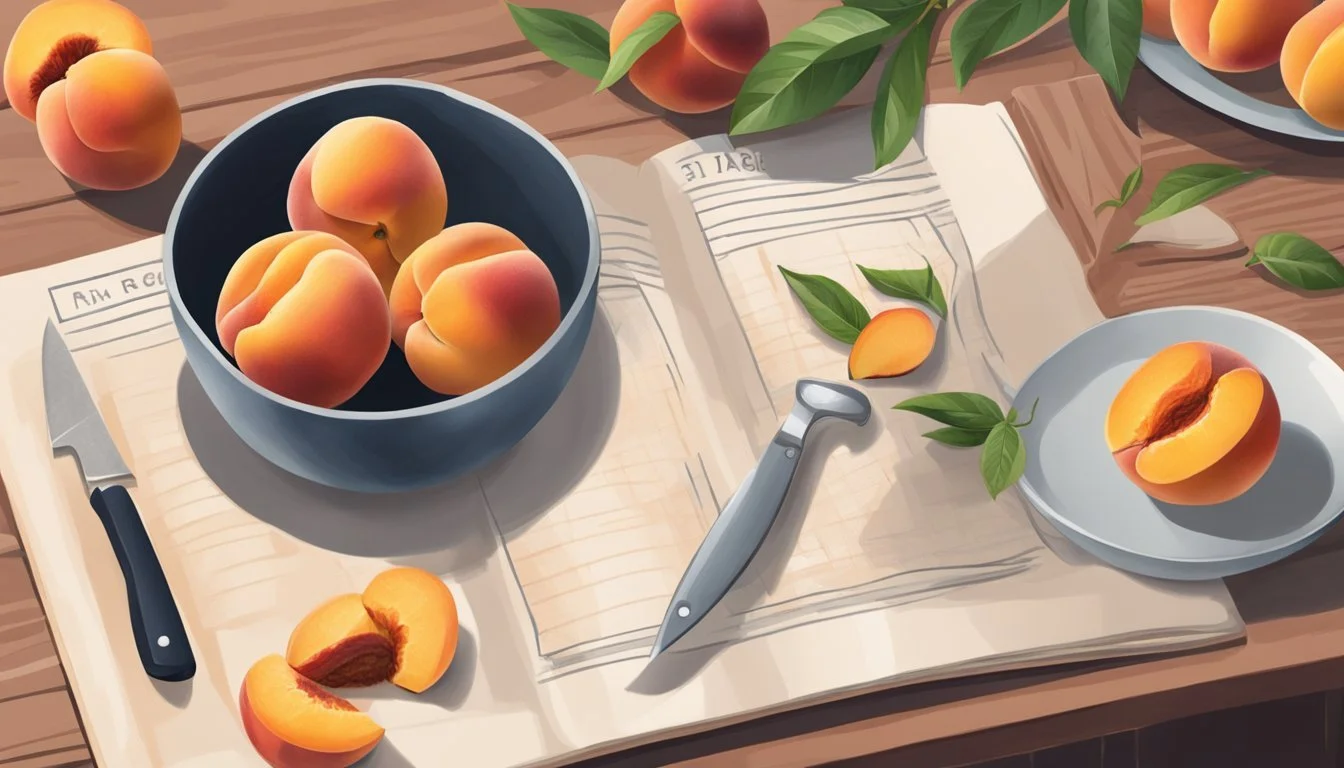Frozen vs Fresh Peaches: A Juicy Comparison
Peach lovers face a delightful dilemma when choosing between fresh and frozen options. Fresh peaches, with their juicy sweetness and fragrant aroma, evoke memories of summer picnics and farmers markets. Frozen peaches offer convenience and year-round availability, making them a pantry staple for many home cooks.
Both fresh and frozen peaches have their place in the kitchen, with each option shining in different culinary applications. Fresh peaches are ideal for eating out of hand or in dishes where their texture is paramount. Frozen peaches excel in baked goods, smoothies, and sauces where their pre-sliced nature and consistent ripeness are advantageous.
Cost and seasonality also factor into the fresh versus frozen debate. While fresh peaches can be a bargain during peak season, frozen varieties often provide better value outside of summer months. Grocery stores stock frozen peaches year-round, ensuring access to this versatile fruit regardless of the season.
Understanding Peaches
Peaches are beloved summer fruits known for their sweet flavor and juicy texture. They come in different varieties and offer nutritional benefits, with availability varying throughout the growing season.
Types of Peaches
Peaches fall into two main categories: freestone and clingstone. Freestone peaches have flesh that separates easily from the pit, making them ideal for eating fresh or slicing. Clingstone peaches have flesh that adheres to the pit, often used for canning and preserving.
White and yellow peaches are common varieties. White peaches tend to be sweeter and less acidic, while yellow peaches have a more classic tangy-sweet flavor. Donut peaches, with their flattened shape, offer a unique visual appeal.
Nectarines are smooth-skinned cousins of peaches, lacking the fuzzy exterior but sharing similar flavors and uses.
Peach Season and Harvesting
Peak peach season typically runs from late June through August, with some regional variations. Farmers markets often showcase the freshest local peaches during this time.
Ripe peaches yield slightly to gentle pressure and emit a sweet aroma. They continue to ripen after picking, so slightly firm peaches can be purchased and left at room temperature to soften.
Commercial growers often harvest peaches before they're fully ripe to withstand shipping. This practice can result in less flavorful fruit compared to tree-ripened peaches from local orchards.
Nutritional Value of Peaches
Peaches are a nutritious addition to any diet. They're low in calories and provide a good source of vitamins and minerals.
A medium peach contains:
Calories: about 60
Vitamin C: 10% of the daily value
Vitamin A: 6% of the daily value
Potassium: 2% of the daily value
Peaches also contain antioxidants like flavonoids and carotenoids, which may help protect against certain diseases. Their fiber content supports digestive health and can contribute to feelings of fullness.
The fruit's natural sweetness makes it a healthier alternative to processed snacks, satisfying sugar cravings without added refined sugars.
Comparing Fresh and Frozen Peaches
Fresh and frozen peaches each offer distinct advantages for different culinary applications. Their taste, texture, nutrient content, and availability vary significantly, impacting how they're best used in recipes.
Taste and Texture Differences
Fresh peaches provide an unmatched eating experience when perfectly ripe. They offer a juicy, tender texture and full-bodied flavor that's hard to replicate. The aroma of a fresh peach is also more pronounced.
Frozen peaches, while not as texturally complex, maintain much of their flavor. They tend to be softer when thawed, making them ideal for baked goods and smoothies. Frozen peaches are often picked at peak ripeness, ensuring good flavor even out of season.
Some cooks prefer frozen peaches for pies and cobblers, as they release less liquid during baking compared to fresh peaches. This can result in a less soggy crust.
Nutrient Retention
Fresh peaches are rich in vitamins, minerals, and antioxidants when consumed soon after harvest. However, their nutrient content can decline during storage and transportation.
Frozen peaches are typically flash-frozen shortly after picking, which helps lock in nutrients. This process can preserve vitamins and minerals effectively, sometimes resulting in higher nutrient content compared to fresh peaches that have been stored for extended periods.
Both fresh and frozen peaches are good sources of vitamin C, fiber, and various antioxidants. The freezing process does not significantly impact these beneficial compounds.
Convenience and Availability
Fresh peaches have a limited season, typically peaking from late June to late August. They require careful handling and have a short shelf life, often lasting only a few days at room temperature or up to two weeks when refrigerated.
Frozen peaches offer year-round availability and extended storage life. They come pre-pitted and sliced, saving preparation time. A bag of frozen peaches can be stored in the freezer for several months without significant quality loss.
For impromptu baking or cooking, frozen peaches eliminate the need to wait for fruit to ripen. They're also often more budget-friendly, especially when fresh peaches are out of season.
Culinary Uses
Peaches offer versatility in the kitchen, lending their sweet flavor and juicy texture to a wide range of dishes. They shine in both sweet and savory applications, from baked goods to grilled entrees.
Baking with Peaches
Peaches elevate various baked goods with their natural sweetness and vibrant flavor. In pies, the fruit creates a luscious filling when mixed with sugar and spices. For muffins or quick breads, chopped peaches add moisture and bursts of fruity goodness.
Peach cobbler stands out as a classic dessert. The dish combines a tender, biscuit-like topping with a warm peach filling. Frozen peaches work well in cobblers, providing consistent results year-round.
When baking with peaches, adjust sugar levels based on the fruit's ripeness. Riper peaches require less added sweetener. For best results, slice peaches uniformly to ensure even cooking.
Making Peach Desserts
Peaches star in numerous desserts beyond baked goods. Peach ice cream offers a refreshing summer treat, while peach sorbet provides a lighter alternative. Blending frozen peaches creates smooth, creamy smoothies packed with flavor.
Peach trifles layer cubed cake, fresh or cooked peaches, and whipped cream for an elegant dessert. For a quick treat, grilled peaches topped with a dollop of vanilla ice cream showcase the fruit's versatility.
Peach jam or preserves capture the fruit's essence for year-round enjoyment. These spreads work well on toast or as fillings for pastries and cakes.
Peaches in Salads and Salsas
Fresh peaches add a sweet contrast to savory salads. Sliced peaches pair well with peppery arugula, tangy goat cheese, and toasted nuts. A light vinaigrette balances the flavors.
Peach salsa offers a fruity twist on the traditional condiment. Combine chopped peaches with red onion, jalapeño, cilantro, and lime juice. This versatile salsa complements grilled meats or works as a dip for chips.
For a unique appetizer, wrap peach slices in prosciutto. The salty-sweet combination provides a perfect balance of flavors.
Cooking and Grilling
Grilled peaches make an excellent side dish or dessert. Halve and pit the fruit, then grill cut-side down until lightly charred. Serve with savory dishes or drizzle with honey for a sweet treat.
Peaches can be incorporated into savory main dishes. They pair well with pork or chicken in stir-fries or skillet meals. Their sweetness balances spicy or tangy sauces.
For a simple dessert, poach peaches in wine or juice. This method softens the fruit and infuses it with additional flavor. Serve poached peaches over yogurt or ice cream for an elegant finish to a meal.
Preparation and Storage Tips
Proper handling and storage techniques help maintain the quality and flavor of peaches, whether fresh or frozen. These methods ensure you can enjoy delicious peaches year-round.
Handling and Peeling Fresh Peaches
To peel fresh peaches easily, score an "X" on the bottom with a paring knife. Dip the peaches in boiling water for 30-60 seconds, then transfer to ice water. The skin should slip off effortlessly.
For slicing, cut along the seam and twist to separate the halves. Remove the pit and slice as desired.
When washing peaches, use a mixture of water and vinegar (1/3 cup vinegar per sink of water) to clean them thoroughly.
Freezing and Defrosting Techniques
To freeze peaches, peel and slice them. Arrange slices on a parchment-lined sheet pan and freeze until solid. Transfer to freezer bags, removing excess air.
Add Fruit Fresh or citric acid to prevent browning. Label bags with the date and use within 6 months for best quality.
To defrost, place frozen peaches in the refrigerator overnight. For faster thawing, submerge the sealed bag in cold water.
Prolonging Freshness
Store ripe peaches in the refrigerator for up to 5 days. Place them in a plastic bag with small holes for air circulation.
For unripe peaches, leave them at room temperature. To speed up ripening, place them in a paper bag with a banana or apple.
Check stored peaches daily and remove any that show signs of spoilage to prevent it from spreading to others.
Recipes and Ideas
Peaches offer versatile culinary applications in both fresh and frozen forms. From classic pies to innovative desserts, their sweet flavor and juicy texture elevate a wide range of recipes.
Classic Peach Pie
A timeless favorite, peach pie showcases the fruit's natural sweetness. For the best results, use ripe, freestone peaches when making a fresh pie. Slice the peaches thinly and toss with sugar, cinnamon, and a touch of lemon juice.
A lattice top crust adds visual appeal and allows steam to escape during baking. For a twist, try a streusel topping instead of a traditional top crust.
Frozen peaches work well in pies too. Thaw and drain them first to prevent excess moisture. A custard peach pie combines the fruit with a creamy filling for added richness.
Refreshing Peach Smoothie
Peach smoothies offer a quick, healthy treat perfect for warm days. Fresh peaches provide the best flavor, but frozen peaches create a thicker, frostier texture.
Blend peach slices with yogurt, milk, and honey for a basic smoothie. Add a banana for extra creaminess. For a dairy-free version, use almond milk and coconut yogurt.
Boost nutrition by including spinach or kale - the peach flavor masks the greens. A dash of cinnamon or nutmeg enhances the peach taste. Frozen peach slices eliminate the need for ice, resulting in a more concentrated flavor.
Innovative Dessert Concepts
Peaches lend themselves to creative desserts beyond traditional pies and cobblers. A peach crisp pairs the fruit with a crunchy oat topping. For individual servings, bake peach crisps in ramekins.
Grilled peaches make an elegant dessert. Brush halved peaches with honey and grill until lightly charred. Serve with mascarpone cheese and a drizzle of balsamic reduction.
Peach cake offers another delicious option. Fold fresh or thawed frozen peach chunks into a butter cake batter. Top with a cream cheese frosting for added decadence.
Peaches as a Substitute
Peaches can replace other fruits in many recipes. They work well in muffins, scones, and quick breads as a substitute for apples or berries.
In fruit salads, peaches add sweetness and color. They pair particularly well with berries and tropical fruits like mango and pineapple.
For savory dishes, peaches can replace mangoes in salsas or chutneys. They complement grilled meats, especially pork and chicken. Frozen peaches, once thawed, make an excellent substitute for canned peaches in recipes like cobbler or dump cakes.




